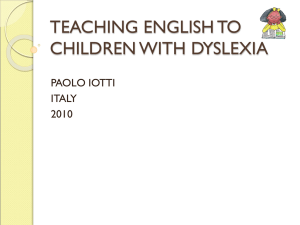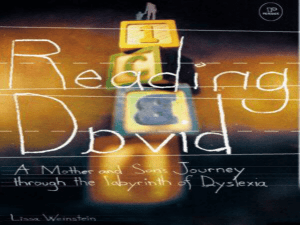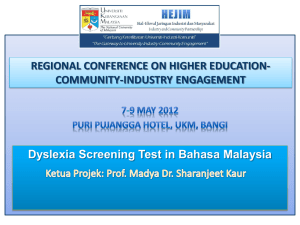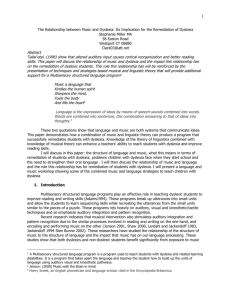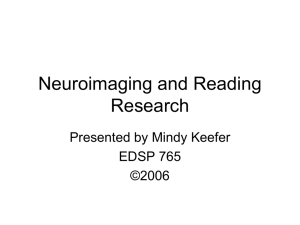What is Dyslexia?
advertisement
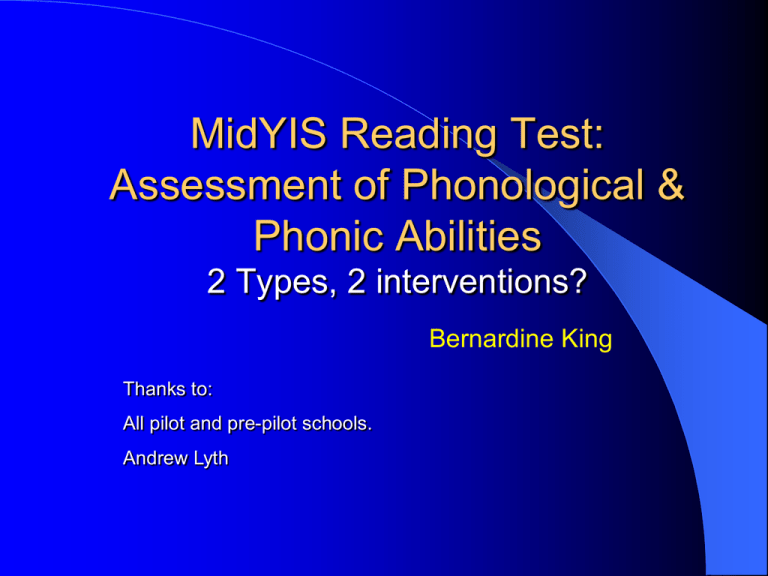
MidYIS Reading Test: Assessment of Phonological & Phonic Abilities 2 Types, 2 interventions? Bernardine King Thanks to: All pilot and pre-pilot schools. Andrew Lyth Summary 1. 2. 3. 4. Dyslexia – what is it? Theoretical rationale behind the test sections. Results from Pilot. Applications & Limitations of test – what can it be used for? The Task To produce a screener that is: Accurate. Short, making holistic statements. Suggests definite courses of action. Purpose of Test Part of a new reading test for MidYIS intended to assess various levels of literacy ability: Phonological & phonic skills. Providing information useful in deciding who may need specialist assessment for dyslexia, etc. Vocabulary – picture and sound. Comprehension - component skills, e.g. inference making. Advantages of the Test Fits within a lesson. Short sub-tests and partly adaptive, designed to minimize stress. Gives an overall estimate of the likelihood of having a literacy difficulty such as dyslexia. But does NOT diagnose it! Advantages of the Test, cont’d Suggests the type of deficit, so can inform future strategies. Synergies with the main MidYIS test – offers an holistic picture of the student. Rose Report, June 2009 What is Dyslexia? The review’s working definition: 1. A learning difficulty that primarily affects the skills involved in accurate and fluent word reading and spelling. What is Dyslexia? 2. Characteristic difficulties in: phonological awareness verbal memory verbal processing speed. What is Dyslexia? 3. Occurs across the range of intellectual abilities. 4. A continuum, not a distinct category. 5. No clear cut-off points. Ehri’s phases of Reading Development Letter-sound links: Consolidated Full alphabetic Partial alphabetic Pre-alphabetic All links including exception spellings All regular spellings Some = ‘partial’ None, iconic reading: eg m in mcDonalds Partial Alphabetic Phase •Letter confusions, b/d, p/q/ •Nonword reading problems: ‘pib’ ‘dalop’ •Salient letters of words attended to, eg 1st & last letters Rationale Behind the Test Sections Test phonological and phonic skills. Phonology- word sounds. Phonological processing deficit in dyslexia. Phonic problems – relating graphemes (letters & letter groups) to the corresponding sounds (phonemes). Tests of Phonology Made-up word (nonword) reading, adaptive test. ‘Sounds’ test – identifying sounds in words. Phonological Short Term Memoryforward & backward digit span. Design of Sub Tests ‘Nonword reading’ and ‘Sounds’ – adaptive, to: match difficulty of items to student ability; Reduce assessment load and time. Phonics Nonword reading- relating graphemes to phonemes. ‘Sounds’- sounds to letters, as in spelling. Pseudohomophone test- made-up words (pseudowords) that sound like real words, e.g. phocks = fox. Also, test of phonology. Pseudohomophone Test Pseudo = made-up word Homophone = sounds like Requires many visual and auditory skills: e.g. reading ‘phocks’ grapheme separation: ‘ph’ ‘o’ ‘ck’ ‘s’ grapheme-phoneme conversion: ‘ph’> /f/ ‘o’> /o/ ‘ck’ > /k/ ‘s’> /s/ Phoneme blending: /f/ /o/ /k/ /s/ Then.. Pseudohomophone Test cont. Match sound package of blended phonemes with items in known sound vocabulary. /f/ + /o/ + /k/ + /s/ = ‘fox’ Added difficulty – word search format. Visual search problems in dyslexia. Choose 5 out of 16 on each of 5 screens. Guessing Nonword reading: 1 in 4 chance. Forced choice multiple choice. ‘Sounds’: 1 in 4 chance. Forced choice multiple choice. Word Search (pseudohomophones): 5 in 16 chance. Can move on without answering. Design of Sub Tests ‘Lyrebird’ Test – an adaptation of a spoken digit span test for computer. Lack of visual distraction- black screen with fixation spot. Response entered on screen. Max number of digits = 8, to reduce assessment load and time. Memory Problems with phonological STM common in dyslexia. Order problemse.g. telephone numbers. Backward digit span –measure of working memory. Short backward digit span often found in dyslexia. The Pilot Pre-pilot: 7 schools. Schools who returned both test files and validation data (n=808): 22 were Independent (all England) 2 were International (1 Vietnam, 1 Qatar) 6 were State schools (3 England, 3 Northern Ireland). Schools who only returned test files: 14 Independent (all England) 8 State (7 England, 1 Wales) 344 Results Genetic program, ‘Eureqa’ (Schmidt & Lipson, e2009). Suggested 2 different cognitive profiles. NVR-strong group, n= 66, distinct from NVR-strong typicals by relationship between nonword reading and Word Search. NVR-weak group, with phonologicsl profile indistinct from NVR-weak typicals. Phonic Profiles Phonics = relationship between graphemes (letters/letter groups) and phonemes (the sounds associated with those graphemes). Asynchrony hypothesis ( e.g. Breznitz, 2002; King, 2009; King, Wood & Faulkner, 2008). Lack of auditory-visual integration in dyslexia. Vector reflecting relationship between phonological and visual abilities / speed of processing. Specific strategies suggested by Type from Test Vocabulary stronger than NVR type: Visuo-spatial memory or cognitive manipulation problem? Practising mental rotations and reflections may help both the NVR and reading skills? Memory visualisations? Strategies for NVR-Strong Dyslexics Poor reverse digit span cf NVR-type typical students implies that training in improving working memory may help. BUT their memory skills are commensurate with typical readers of the strong vocabulary type! Phonology? Subject choices- eg languages. What do Children with Dyslexia think makes good teaching? IDP: 118 (52 primary, 66 secondary) children surveyed. ‘Show don’t just tell’. Be enthusiastic. Help if I get stuck. Be brief, don’t ramble. Write things clearly. Encourage and reward attempts. 2. What do Children with Dyslexia think makes good teaching? Don’t speak too fast. Don’t rush me. Have instructions on the board as a reminder. Don’t embarrass me in front of the class. Tell me where to begin. Give me time to think before I begin a task. Uses & Limitations of the Test Audit of phonological abilities of a cohort. Shows strengths & weaknesses. Does not diagnose dyslexia. Cannot identify ‘recovered’ dyslexic readers. Shows marked phonological / phonic difficulties.



